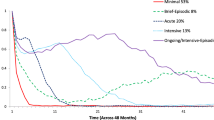Abstract
This study examines longitudinal mental health service use patterns of a school-based sample of adolescents. Based on the Center for Epidemiologic Studies Depression Scale scores, a stratified sample of middle-school students was interviewed using the Schedule for Affective Disorders and Schizophrenia for School-Aged Children: cycle one (n = 579; mean age 12.83) and cycle two (n = 490; mean age 18.65). Service use also was assessed by mailed questionnaire: cycle three (n = 330; mean age 20.60). Service use decreased over time. Whites and males received significantly more treatment in the first cycle. In the second cycle, service use by race and gender was equal; in the third cycle, females received more treatment. Those with a psychiatric diagnosis (first cycle 54%; second cycle, 33%) received treatment in the prior year. Under-treatment of youth with psychiatric diagnoses is a significant problem, with differences in service use by race and gender over time.
Similar content being viewed by others
References
Anderson JC, Williams S, McGee R, et al. DSM-III disorders in preadolescent children: prevalence in a large sample from the general population.Archives of General Psychiatry. 1987;44:69–76.
Beitchman J. Social class, symptom type, and the utilization of children's psychiatric services.Canadian Psychiatric Association Journal. 1978;23:297–302.
Langner TS, Gersten JC, Greene EL, et al. Treatment of psychological disorders among urban children.Journal of Consulting and Clinical Psychology. 1974;42:170–179.
Offord DR, Boyle MH, Szatmari P, et al. Ontario child health study: II. Six month prevalence of disorder and rates of service utilization.Archives of General Psychiatry. 1987;44:832–836.
Leaf PJ, Alegria M, Cohen P, et al. Mental health service use in the community and schools: results from the four-community MECA study.Journal of the American Academy of Child and Adolescent Psychiatry. 1996;5(7):889–897.
Cohen P, Kasen S, Brook JS, et al. Diagnostic predictors of treatment patterns in a cohort of adolescents.Journal of the American Academy of Child and Adolescent Psychiatry. 1992;31:951–960.
Zahner GEP, Pawelkiewicz W, DeFrancesco JJ, et al. Children's mental health service needs and service utilization patterns in an urban community.Journal of the American Academy of Child and Adolescent Psychiatry. 1992;31:951–960.
Cuffe SP, Waller JL, Cuccaro MLZ, et al. Race and gender differences in the treatment of psychiatric disorders in young adolescents.Journal of the American Academy of Child and Adolescent Psychiatry. 1995;34(11):1536–1543.
Cohen P, Hesselbart CS. Demographic factors in the use of mental health services.American Journal of Public Health. 1992;82:49–52.
Andreasen NC, Rice J, Endicott J, et al. Familial rates of affective disorder: a report from the National Institute of Mental Health collaborative study.Archives of General Psychiatry. 1987;44:461–469.
Orvaschel H, Thompson WD, Belanger A, et al. Comparison of the family history method to direct interview: factors affecting the diagnosis of depression.Journal of Affective Disorders. 1982;4:49–59.
Hoberman HM. Ethnic minority status and adolescent mental health services utilization.Journal of Mental Health Administration. 1992;19:246–267.
Costello EJ, Janiszewski S. Who gets treated? Factors associated with referrals in children with psychiatric disorders.Acta Psychiatrica Scandinavica. 1990;81:523–529.
Sue S, Fujino DC, Hu L, et al. Community mental health services for ethnic minorities: a test of the cultural responsiveness hypothesis.Journal of Consulting and Clinical Psychology. 1991;59:533–540.
Radloff LS. The CES-D scale: a self-report depression scale for research in the general population.Applied Psychological Measurement. 1977;1:385–401.
Chambers WJ, Puig-Antich J, Hirsch M, et al. The assessment of affective disorders in children and adolescents by semistructured interview: test-retest reliability of the Schedule for Affective Disorders and Schizophrenia for School-Age Children, Present Episode Version.Archives of General Psychiatry. 1985;42:696–702.
American Psychiatric Association.Diagnostic and Statistical Manual of Mental Disorders. 4th ed. Washington, DC: American Psychiatric Association; 1995.
Shaffer D, Gould MS, Brasic J, et al. A children's global assessment scale (CGAS).Archives of General Psychiatry. 1983;40:1228–1231.
Garrison CZ, Jackson KL, Addy CL, et al. Suicidal behaviors in young adolescents.American Journal of Epidemiology. 1991;133(10):1005–1014.
Hollingshead AB, Redlich FC, eds.Social Class and Mental Illness. New York: John Wiley; 1958.
Schoenbach VJ, Kaplan BH, Grimson RC, et al. Use of a symptom scale to study the prevalence of a depressive syndrome in young adolescents.American Journal of Epidemiology. 1982;116:791–800.
Shah BV, Barnwell BG, Bieler GS, eds.SUDAAN User's Manual, Release 7.0. Research Triangle, NC: Research Triangle Institute; 1996.
Cohen P, Cohen J, Kasen S, et al. An epidemiological study of disorders in late childhood and adolescence: I. Age and gender-specific prevalence.Journal of Child Psychology and Psychiatry and Allied Disciplines. 1993;34:851–867.
Burke JD. Mental health services research. In: Tsuang MT, Tohen M, Zahner GEP, eds.Textbook in Psychiatric Epidemiology. New York: Wiley-Liff, Inc; 1995:199–209.
Mrayek PJ, Haggerty RJ, eds.Reducing Risks for Mental Disorders. Washington, DC: National Academy Press; 1994:19–29.
National Institute of Mental Health.Priorities for Prevention Research at NIMH. A Report by the National Advisory Mental Health Council Workgroup on Mental Disorders Prevention Research. Bethesda, MD: Natonal Institutes of Health (NIH Publication No. 98-4321); 1998.
Author information
Authors and Affiliations
Corresponding author
Rights and permissions
About this article
Cite this article
Cuffe, S.P., Waller, J.L., Addy, C.L. et al. A longitudinal study of adolescent mental health service use. The Journal of Behavioral Health Services & Research 28, 1–11 (2001). https://doi.org/10.1007/BF02287230
Issue Date:
DOI: https://doi.org/10.1007/BF02287230




